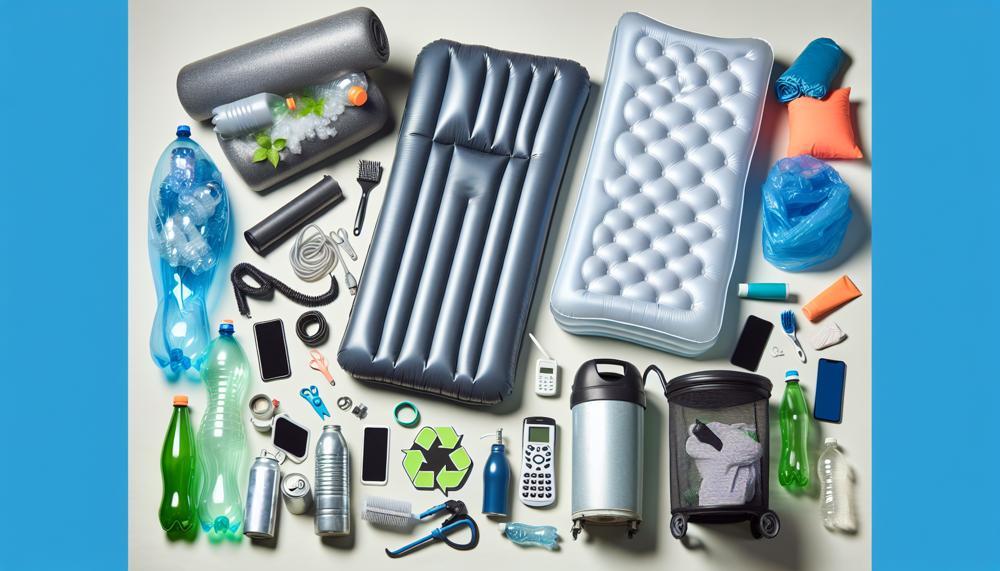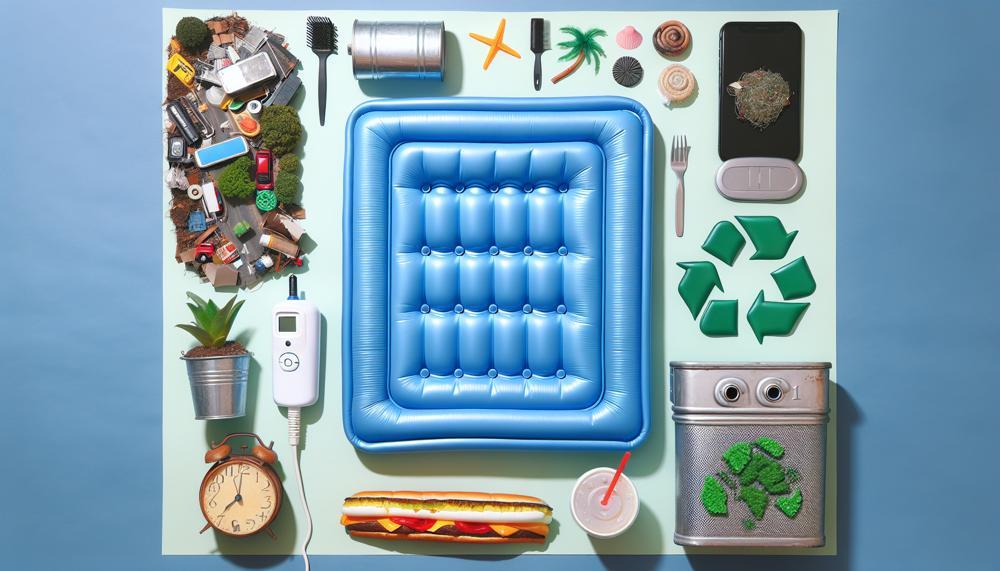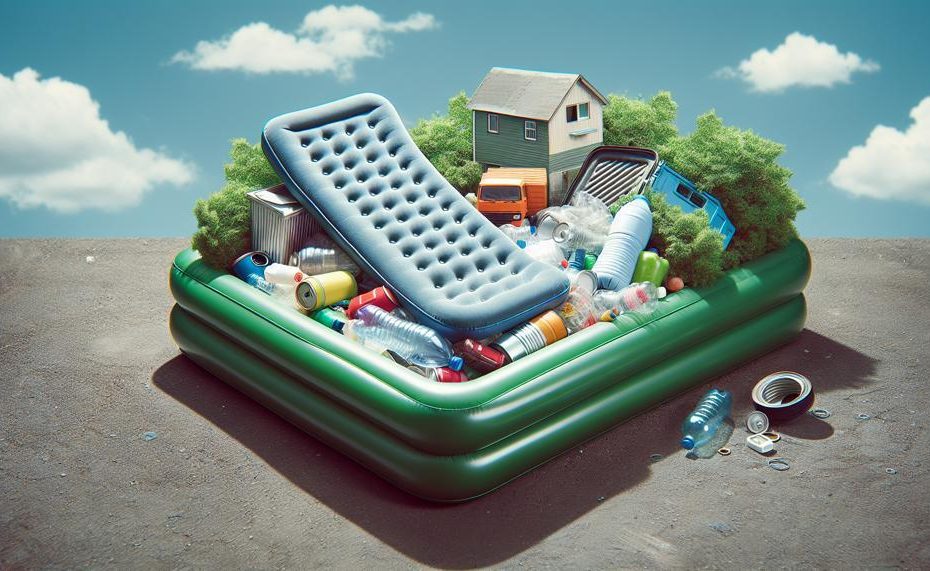It may seem like a trivial matter, but did you know that millions of air mattresses end up in landfills each year, taking centuries to decompose and releasing harmful chemicals into the environment?
As we become more conscious of our actions and their impact on the planet, it’s crucial that we also consider the proper disposal of everyday items like air mattresses.
In this post, we’ll explore why recycling air mattresses is vital for the environment and how we can all play a part in reducing waste. We’ll take a closer look at the various materials used in making air mattresses and how they can be repurposed or recycled.
Plus, we’ll share some ingenious ideas for upcycling old air mattresses instead of simply tossing them away.
So whether you’re an avid camper or someone who enjoys a comfortable night’s sleep on an air mattress, this post is for you.
Let’s dive in and discover how we can make a positive impact on the planet by responsibly recycling our beloved inflatable beds.
Contents
Can You Recycle an Air Mattress?
Recycling an air mattress is definitely possible, but it requires proper preparation and knowledge. Follow these steps to effectively recycle your air mattress:
- Start by checking with your local recycling center to see if they accept air mattresses. If they do, make sure to follow their specific guidelines for preparing the mattress for recycling.
- Before recycling, clean the mattress and remove any fabric or other materials. To make handling and transportation easier, you can also cut the vinyl material into smaller pieces.
- Follow the instructions given by the recycling center for disposing of the mattress.
- If traditional recycling methods are not available, consider donating or repurposing the mattress.
- Don’t forget to recycle the pump that comes with the air mattress.
- Even a punctured air mattress can be recycled as long as it is fully deflated and cut into smaller pieces.
If your local recycling center does not accept air mattresses, explore alternative options such as donation or repurposing.
How to Recycle an Air Mattress:
Recycling an air mattress is crucial to reducing waste and promoting a sustainable future. Here is how you can properly recycle your air mattress:
- Contact your local recycling center: Begin by reaching out to your nearby recycling center to see if they accept air mattresses. Some centers may have specific instructions on how to prepare the mattress for recycling, so be sure to follow them carefully.
- Clean and dismantle the air mattress: Before recycling, make sure to thoroughly clean your air mattress of any dirt or mold. Cut it along the seams and separate the top and bottom parts. These pieces can be used as tarps, drop cloths, or outdoor carpets.
- Research the materials: Look into the materials your air mattress is made of. This will help you find a suitable recycling facility or company that accepts these materials.
- Find a recycling facility or company: If your local recycling center does not accept air mattresses, do some research to find a recycling facility or company that does. You can also contact a bed removal company that specializes in recycling all types of mattresses.
- Prepare for recycling: Follow any specific guidelines provided by the recycling facility for preparing the air mattress for recycling. This may involve cutting it into smaller pieces for easier handling and transportation.
- Consider other options: If recycling is not feasible, think about donating or repurposing your old air mattress instead. Make sure to thoroughly inspect it for any damages and clean it before giving it away or repurposing it.
By properly recycling an air mattress, you not only reduce landfill waste but also contribute to a more sustainable future.
Alternative Ways to Recycle an Air Mattress

Recycling or repurposing your mattress not only helps reduce the amount of waste in landfills, but it also contributes to a more sustainable future.
Below are some creative and environmentally friendly ways to recycle an air mattress:
- Donate it: If your air mattress is still in good condition, consider donating it to a local charity or shelter. This allows someone else to benefit from the mattress and keeps it out of the landfill, reducing waste and giving back to the community.
- Repurpose it: There are many ways to repurpose an old air mattress. For example, it can be used as a portable camping mattress or a ground sheet protector for outdoor activities. You can also cut it into smaller pieces and use them as tarps or drop cloths for DIY projects. Additionally, you can turn it into a shoe rack, outdoor furniture, or even a cozy pet bed for the summer.
- Recycle it: Check with your local recycling center to see if they accept air mattresses. If they do, make sure to follow their guidelines for preparing the mattress for recycling. If not, there are online programs available that allow you to mail in old air mattresses to be recycled.
- Separate and recycle materials: Air mattresses are made up of various materials such as PVC, vinyl, and cloth, which can all be recycled separately. Be sure to properly clean and separate these materials before recycling them.
- Reuse the pump: The pump that comes with an air mattress can also be recycled separately. Check with your local recycling center for guidelines on how to properly dispose of it.
- Properly care for your air mattress: To ensure your air mattress lasts longer and can be reused or recycled, make sure to properly care for it while using it. This includes regularly cleaning and checking for any damages that may require repairs.
By following these alternative ways to recycle an air mattress, not only can you reduce waste and contribute to a more sustainable future, but you can also get creative and give new life to an old item.
How Do I Clean My Air Mattress?
A clean air mattress is vital for both hygiene and extending its lifespan. Here are the recommended methods for cleaning and disposing of air mattresses properly.
Cleaning Techniques:
- Vacuuming: Begin by vacuuming your air mattress to eliminate any surface dirt, dust, or debris.
- Spot-Cleaning: For minor stains, mix a small amount of mild soap with water and gently dab the affected area with a clean cloth. Avoid harsh chemicals or scrubbing vigorously as it can harm the material.
- Deep-Cleaning: For tougher stains or odors, you can deep-clean your air mattress using a blend of equal portions of water and white vinegar. Apply the solution to the stain and let it sit for 10-15 minutes before wiping it off with a damp cloth.
- Air-Drying: Once you have thoroughly cleaned your air mattress, ensure it dries completely before storing it away. Avoid using a dryer or direct heat as they can damage the material.
Disposal Methods:
- Check for Recycling Options: Before throwing out your air mattress, check if there are any recycling options available in your area. Some recycling facilities accept plastic or vinyl materials, which are commonly used in air mattresses.
- Properly Wrap and Label: If there are no recycling options available, make sure to properly wrap and label your air mattress before disposing of it in a landfill. This will prevent it from causing damage or creating a mess in the landfill.
- Repurpose or Donate: Instead of discarding your old air mattress, consider repurposing it into something new or donating it to someone in need. You can use the material to make cushions, pet beds, or even use it as a waterproof cover for outdoor furniture.
So, maintaining a clean air mattress is crucial for its durability, and proper disposal methods are necessary to reduce waste.
Is an air mattress plastic?

An air mattress is commonly crafted using Polyvinyl Chloride (PVC), rubber, or Thermoplastic Urethane (TPU). The material chosen for an air mattress has a direct influence on its level of comfort, durability, and cost.
Here, we will delve deeper into the different materials and their unique properties to guide you in making an informed decision when selecting an air mattress.
PVC
PVC is the most widely used material for air mattresses due to its affordability. It is a type of plastic that is lightweight and easy to manufacture. However, PVC does not excel in temperature regulation and can become uncomfortable to sleep on during hot weather.
Additionally, PVC air mattresses tend to have a shorter lifespan compared to other materials.
Rubber
Rubber is less commonly used than PVC but boasts higher durability. It has a higher weight capacity and can withstand more weight without losing its shape.
However, rubber air mattresses are heavier and bulkier, making them less convenient for travel. They also come with a higher price tag, ranging from $9 to $28.
TPU
Thermoplastic Urethane (TPU) is the most durable material used for air mattresses. It is resistant to punctures and can withstand heavy use without losing its shape.
TPU air mattresses are also better at regulating temperature and providing comfort during hot weather.
However, they are also the most expensive option, with prices ranging from $80 to $350.
Consider Your Needs
When choosing an air mattress, it’s crucial to consider your unique needs and preferences. If you’re on a budget and will only be using the air mattress occasionally, a PVC one may suffice.
However, if you plan on using the air mattress frequently or require it for camping or outdoor activities, a more durable material like rubber or TPU may be a better choice.
So, an air mattress can be crafted using various materials, including PVC, rubber, or TPU. Each material has its own set of characteristics and price range, making it essential to carefully consider your needs before making a decision.
Are air mattresses safe for kids?
While these beds may seem like a convenient and comfortable option, they actually come with hidden dangers that could pose serious risks to children. Here are some important safety hazards to keep in mind:
Risk of suffocation
It is not recommended for infants and toddlers to sleep on air mattresses due to the risk of suffocation.
These beds do not have the necessary support and firmness to prevent accidental suffocation, and young children could become trapped between the mattress and bed frame, putting them in danger.
Lack of proper support
Children need proper support while sleeping to promote healthy growth and development.
However, air mattresses lack the structure and firmness of traditional mattresses, which can lead to back pain, neck pain, and disrupted sleep for kids who regularly use them.
Potential for falls and sudden deflation
Air mattresses can be unstable and increase the risk of falls or sudden deflation during sleep, especially for younger children who tend to move around frequently while sleeping.
Sudden deflation can also cause discomfort or injury for children.
Allergens and dust mites
Air mattresses can easily attract allergens and dust mites if not properly maintained or cleaned regularly. This can be particularly problematic for children with allergies or respiratory issues.
To ensure the safety of your children, it is best to avoid using air mattresses as a long-term bedding option. Instead, consider alternatives such as futons or traditional mattresses that offer better support and comfort for growing bodies.
If you do decide to use an air mattress for temporary purposes, make sure to follow proper maintenance guidelines and supervise young children at all times while using it.
Are intex air mattresses recyclable?
Recycling is a crucial action in the fight against waste and preserving our environment. Fortunately, Intex air mattresses are free of PVC and can be recycled at plastic recycling centers. This makes them a sustainable choice for those looking to discard their old air mattresses.
However, not all air mattresses are recyclable, so it is essential to conduct thorough research or seek expert advice when considering recycling options.
It is also worth noting that, while recycling is an excellent step, proper maintenance and care of your air mattress should also be considered to prolong its lifespan and decrease waste.
We must prioritize recycling to reduce our environmental impact. Intex Air mattresses offer a sustainable solution for disposing of old mattresses as they are free of PVC, a common material that is harmful to our planet. By choosing to recycle, we can contribute to preserving our environment for future generations.
But it’s not just about recycling; we must also take care of our belongings to minimize waste. Ensuring proper maintenance and following care instructions can significantly increase the lifespan of an air mattress. This way, we can reduce the need for frequent replacements and ultimately lessen our environmental impact.
Where to donate an air mattress
Regrettably, air mattresses are generally not suitable for donation as they may pose hygiene and safety risks. But don’t worry; there are still ways to ethically dispose of your used air mattress.
When it comes to donating items, we often think of clothes, household items, and furniture. But what about mattresses? Most charities and shelters do not accept air mattresses due to the potential for mold, mildew, or bed bugs. And while it may seem wasteful to simply throw away a perfectly good air mattress, there are important reasons for this restriction.
Air mattresses cannot be sanitized in the same way that other items can. And donating used air mattresses can create a cycle of harm, as they may end up being passed along to those in need without proper sanitation. This can lead to the spread of illness and pests, creating a much larger problem than just disposing of an old mattress.
There are still eco-friendly options for getting rid of your old air mattress. Many cities offer recycling programs specifically for mattresses and other bulky items. These programs will properly disassemble and recycle the various materials that make up an air mattress, preventing them from ending up in landfills.
Another option is to check with your local waste management company for bulk item pick-up services. Many companies now offer this service for a small fee, making it easy and convenient to dispose of large items like air mattresses in an environmentally responsible way.
And if you’re feeling creative, you could even repurpose your old air mattress into something new and useful. With a little bit of DIY know-how, you could turn your old air mattress into a waterproof tarp or even a pool float. The possibilities are endless.
So, while donating an old air mattress may not be possible, we can still make responsible choices when it comes to disposing of them.
Remember to always check with your local recycling and waste management services for more information on environmentally friendly options.
Conclusion
In conclusion, the question of whether air mattresses can be recycled is not one to take lightly. The staggering number of these inflatable beds that end up in landfills each year is a pressing issue, as they can take centuries to decompose and release harmful chemicals into the environment.
As responsible consumers, it is our duty to consider the proper disposal of everyday items like air mattresses.
Throughout this blog post, we have delved into why recycling air mattresses is crucial for the health of our planet and how we can all do our part in reducing waste. We have also explored the various materials used in making air mattresses and their potential for repurposing or recycling.
In addition, we have discovered some clever ways to upcycle old air mattresses instead of simply discarding them.
Whether you are an avid camper or someone who enjoys a comfortable night’s sleep on an air mattress, it is vital to dispose of these inflatable beds in an environmentally friendly manner.
By following the steps outlined in this article, we can make a positive impact on the planet and contribute to a more sustainable future.
Remember to always check with your local recycling center for specific guidelines and alternative options such as donation or repurposing.





